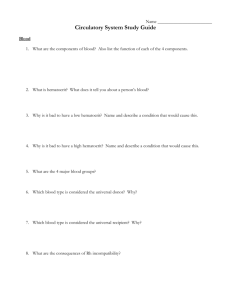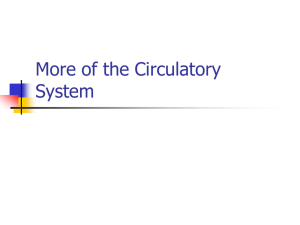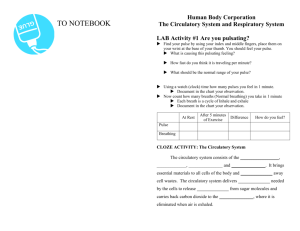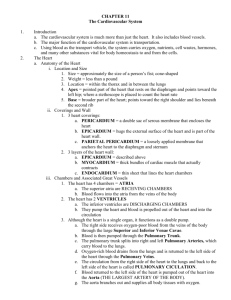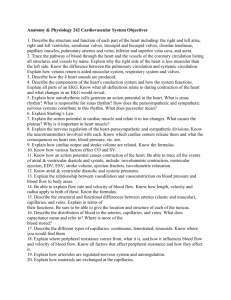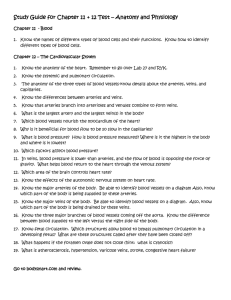File - Ms. McGowan's Science Page
advertisement
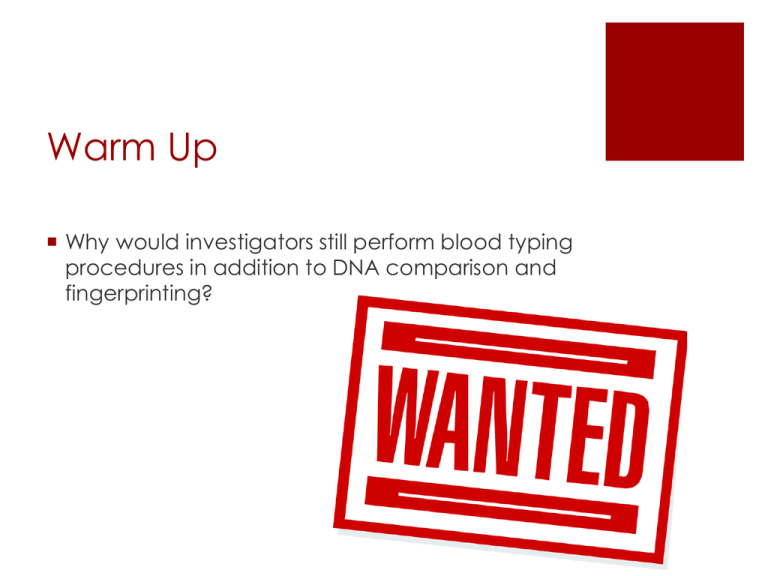
Warm Up Why would investigators still perform blood typing procedures in addition to DNA comparison and fingerprinting? Objective: SWBAT Identify areas of improvement prior to tomorrow’s blood test Agenda: Pass back papers Blood Review Packet Closing Homework: Blood Test Tomorrow Blood Review Packet Working together, complete your blood review packet Closing Identify at least one area that you need more clarification on before tomorrow’s test. Warm Up Write a creative short story explaining how blood clots. Imagine you are the broken blood vessel. Be sure to create names for each character (EX: Paul the Platelet) Pass your case studies packet to the aisle for collection Objective: SWBAT Score >80% on their blood test Agenda: Pass Back Papers Cell Phone Pouches Blood Test Closing Homework: None! Blood Test Put everything away except for a writing utensil If you have a question during your test, please raise your hand and I will come to you When you are done, hold on to your test; all tests will be collected at the end Good luck! Closing How do you think you did on your test? Why do you think you performed this way? Consider how you participate in class and how you study. Warm Up Once blood becomes oxygenated in the lungs, where does it go? Objective: SWBAT Explain how deoxygenated and oxygenated blood moves through the 4 chambers of the heart Agenda: Pass back papers Guided Notes: Anatomy of the Heart Heart Contraction Animation The Heart Cycle Activity Closing Homework: None! Guided Notes: Anatomy of the Heart Size, Location, Orientation Size of a fist, weighing less than a pound Located between two lungs between 2nd and 5th ribs Cone-shaped with its apex pointing toward your left hip Coverings of the Heart Pericardium—encloses heart Fibrous pericardium—serves as a superficial anchor of the heart Serous pericardium—sac of lubricating fluid deep to the fibrous pericardium Guided Notes: Anatomy of the Heart Right atrium (Receives deoxygenated blood from body via superior and inferior venae cavae) Left atrium (Receives oxygenated blood from lungs via pulmonary veins) Right ventricle (Pumps deoxygenated blood to lungs via pulmonary arteries) Left ventricle (Pumps oxygenated blood to body via aorta) Arteries carry blood AWAY from heart, while veins carry blood TOWARD the heart Pulmonary vs. systemic circulation—lungs vs. rest of body Guided Notes: Anatomy of the Heart Heart Valves—prevent backflow of blood during contraction AV (atrioventricular) valves—open during relaxation, closed during contraction Bicuspid or mitral valve—left AV valve Two flaps or cusps, looks like a mitre (pope’s headdress) Tricuspid valve—right AV valve Three flaps or cusps Flaps do not push backwards into atria due to chordae tendineae attached to inferior portion of ventricles Semilunar valves—closed during relaxation, open during contraction Pulmonary valve and Aortic valve Both made up of 3 leaflets, forced open by pressure of blood, forced closed by blood pooling in leaflets Guided Notes: Anatomy of the Heart Cardiac Circulation Blood that energizes heart muscle is different than the blood it pumps Comes from coronary arteries, drains to cardiac veins into right atrium Heart Contraction Animation http://www.nhlbi.nih.gov/health/healthtopics/topics/hhw/contraction.html Warm Up How do deoxygenated and oxygenated blood move through the 4 chambers of the heart? Use appropriate terms. Objective: SWBAT Determine how cardiac output and stroke volume change depending on physical activity Agenda: Guided Notes: Physiology of the Heart Heart Animation Cardiac Cycle Lab Closing Homework: Finish Lab Questions Guided Notes: Physiology of the Heart Fun facts: 6L of blood passes through heart 1,000x/day! Cardiac muscle will contract even when all nerve connections are severed! (Only until lack of O2 and ATP) Intrinsic Conduction System of the Heart: Setting the Basic Rhythm SA (sinoatrial) node Located in right atrium Depolarizes cells, causing contraction of the left and right atria Keeps heart beating ~75bpm Also known as the pacemaker! AV (atrioventricular) node Located between the right atrium and ventricle Depolarizes cells to send contraction signal to Bundle of His Bundle of His Located in wall separating left and right ventricles Depolarizes cells to send contraction signal to Purkinje fibers Purkinje fibers Located in walls surrounding left and right ventricles Depolarizes cells, causing contraction of the left and right ventricles Guided Notes: Physiology of the Heart Other Factors that Can Change Heart Rate Autonomic nervous system (fight or flight vs. rest and digest) Hormones (Epinephrine/Norepinephrine) Physical factors (age, gender, exercise, body temperature) Cardiac Cycle and Heart Sounds Cardiac cycle—the events of one complete heartbeat (both atria and ventricles contract and relax) About 0.8 seconds Systole—contraction of the ventricles Diastole—relaxation of the ventricles Heart Sounds Lub—AV valves close (long and loud) Dub—Semilunar valves close (short and sharp) Cardiac Output Cardiac Output (CO)—the volume of blood pumped out by each ventricle in 1 minute Stroke Volume (SV)—the volume of blood pumped out by a ventricle with each heartbeat Heart Rate (HR)—number of heartbeats per minute CO=HR x SV Heart Animation https://highered.mcgrawhill.com/sites/0072495855/student_view0/chapter 22/animation__conducting_system_of_the_heart. html Cardiac Cycle Lab! Pick a partner of your choice, follow the directions on your lab to determine how cardiac output and stroke volume change with exercise Warm Up How does stroke volume change with exercise? Pass your cardiac cycle lab to the aisle for collection Objective: SWBAT Identify sheep heart anatomy Agenda: Sheep Heart Dissection Closing Homework: Finish Heart Dissection Questions Sheep Heart Dissection Please send one person from each lab station to retrieve a sheep heart Then, follow your directions to explore sheep heart anatomy! Warm Up 1. Which chamber of the sheep heart was the largest? Why is this? 2. Which heart structures have we learned about that we were unable to visualize during our dissection yesterday. You should be able to come up with at least 5 terms. Objective: SWBAT Brainstorm and explain the differences in arteries, veins, and capillaries Brainstorm and explain how blood returns to the heart against gravity Brainstorm how fetal circulation must differ from adult circulation to create a fetal heart diagram Agenda: Brainstorming: Blood Vessels Blood Vessels Discussion Blood Vessel Notes Closing Homework: Fetal Heart Drawing and Blood Vessel Questions Brainstorming: Blood Vessels In your small groups, brainstorm the answers to the questions given. Although I do not expect you to know the answers, I expect you to get close to the answers using prior knowledge and reasoning. Notes: Blood Vessels Fun fact: The vascular system was not discovered until 1616 by William Harvey, an English physician Arteries (larger) and arterioles (smaller)—move blood AWAY from heart Thicker walls than veins Capillary Beds—place where gas and nutrient exchange take place Smallest diameter of all blood vessels Thinnest walls Venules (smaller) and veins (larger)—move blood TOWARD the heart Thinner walls than arteries Notes: Blood Vessels Mechanisms to Counteract Low Blood Pressure in Veins Veins contain valves to prevent backflow Skeletal muscle squeezes veins, “milking” blood back to the heart Inhalation causes diaphragm to move down, creating low pressure Notes: Blood Vessels Special Circulations Brain Supplied by carotid and vertebral arteries The Circle of Willis—circle of blood vessels Allows multiple routes for blood to travel Notes: Blood Vessels Fetus Respiratory and digestive systems are not yet developed Receives oxygen and other nutrients (and excretes carbon dioxide and wastes) from mother’s blood through umbilical cord and placenta Special structures: Ductus venosus—bypasses blood past liver, back to the heart through inferior vena cava Foramen ovale—shunt between right atrium and left atrium Ductus arteriosis—shunt between pulmonary artery and aorta Notes: Blood Vessels Liver All blood from the digestive organs, spleen, and pancreas passes through liver before returning to the heart Nutrients and wastes from food are absorbed into capillaries This blood is sent to the liver through the hepatic portal vein Nutrients and wastes in blood are absorbed into the liver Blood moves back to the heart Fetal Circulation Animation http://www.muschealth.com/video/Default.aspx ?videoId=10019&cId=34&type=rel Fetal Circulation Drawing Using the rest of class, work individually to alter the printed lines of the adult heart given to you to reflect the fetal heart Then, use blue and red colored pencils to color the parts of the fetal heart that receive deoxygenated blood and oxygenated blood Warm Up How and why does the fetal heart differ from the adult heart? Pass your homework to the aisle for collection Objective: SWBAT Locate and measure their own pulse from their temporal, facial, carotid, brachial, radial, popiteal, posterior tibial, and dorsalis pedis arteries. Measure the blood pressure of three other students using the brachial artery. Agenda: Notes: Blood Pressure Blood Pressure Lab Closing Homework: Finish your Blood Pressure Lab Questions Notes: Blood Pressure Vital signs—various statistics physicians use to determine health Pulse Blood pressure Respiratory rate Body temperature Notes: Blood Pressure Pulse Expansion and recoil of arteries with each beat of blood from the left ventricle Same as heart rate Can be taken at multiple arteries: Temporal, facial, carotid, brachial, radial, femoral, popiteal, posterior tibial, doralis pedis Don’t use thumb because has own pulse Also known as pressure points—compressed during injury to stop blood loss Notes: Blood Pressure Pressure that blood exerts against the inner walls of blood vessels to keep blood circulating Blood flows from high pressure (in the aorta and arteries) to low pressure (in the veins and vena cava) However, BP in the aorta and arteries change with each beat Systolic pressure—high pressure in arteries at systole (ventricular contraction) Diastolic pressure—low pressure in arteries at diastole (ventricular relaxation) Systolic is recorded over diastolic in mm Hg (millimeters mercury) EX: Average BP is 120/80 mm Hg, but varies widely Notes: Blood Pressure How to Take BP Wrap the blood pressure cuff snuggly around the patient’s arm just above their elbow Slip your stethoscope onto their brachial artery, identifying the patient’s pulse Inflate the cuff until you no longer hear their pulse Slowly reduce pressure in the cuff until their pulse is heard; record this as their systolic pressure Continue to slowly reduce pressure in the cuff until you no longer hear their pulse; record this as their diastolic pressure Blood Pressure Lab Working with a partner, you will practice measuring your pulse at various arteries as well as measuring blood pressure Closing 1. How did your pulse measurements compare at different locations? 2. How did your partners’ blood pressure measurements compare to one another? Warm Up How do you take blood pressure? Objective: SWBAT Locate and measure their own pulse from their temporal, facial, carotid, brachial, radial, popiteal, posterior tibial, and dorsalis pedis arteries. Measure the blood pressure of three other students using the brachial artery. Brainstorm possible factors that affect blood pressure and discuss how this could be tested Agenda: Finish Blood Pressure Lab Brainstorm: Factors Affecting Blood Pressure Notes: Peripheral Resistance Closing Homework: None! Blood Pressure Lab Working with a partner, you will practice measuring your pulse at various arteries as well as measuring blood pressure Brainstorm: Factors Affecting Blood Pressure On your own sheet of paper, (working individually), write down as many possible factors that may affect blood pressure as Ms. McGowan times you We will go over this list as a class Prizes will be involved! Warm Up 4/11 How does standing up affect blood pressure? Why? Pass your Blood Pressure Practice Lab to the aisle for collection Warm Up 4/22 How do you think diuretics such as coffee and alcohol affect blood pressure? Why? Objective: SWBAT Determine how standing up, talking, exercise, fluid, and foods high in salts, saturated fats, and cholesterol actually affect blood pressure. Agenda: Factors Affecting Blood Pressure Lab Peripheral Resistance Notes Closing Homework: Factors Affecting BP Homework Factors Affecting Blood Pressure Lab Working with a partner, follow your directions to discover how different factors actually affect blood pressure Notes: Peripheral Resistance BP = CO x PR Peripheral Resistance—amount of friction blood encounters in vessels An increase in PR = an increase in BP PR generally increases with vasoconstriction, arterial plaques, increased blood volume, and increased blood viscosity Factors Affecting BP and PR Orthostatic pressure results in low BP so baroreceptors (pressure receptors) cause vasoconstriction Hemorrhage results in low BV so baroreceptors cause vasoconstriction Kidneys regulate BV by increasing or decreasing urine output Cold temperature causes vasoconstriction; warm temperature causes vasodilation Epinephrine, nicotine, caffeine cause vasoconstriction; alcohol causes vasodilation Diets high in salt, saturated fats, and cholesterol increase vasoconstriction Closing How does drinking water theoretically affect your blood pressure? What did your results show? Why do you think this is? Warm Up Coffee is a diuretic, but it is also a stimulant. So, how does coffee affect blood pressure? Objective: SWBAT Use their knowledge of the cardiovascular system to determine cause of death of the couple in “The Hot Tub Mystery.” Agenda: Case Study: The Hot Tub Mystery Guided Notes: Blood Vessel Issues Closing Homework: Create a list (as long as you can) of celebrities who have undergone coronary artery bypass surgery Case Study: The Hot Tub Mystery Work together to determine the cause of death (COD) of the couple in “The Hot Tub Mystery” In your groups, take turns reading the case study Answer your questions as you read Warm Up 4/25 How do doctors diagnose cardiovascular issues? Individually, list as many tools as you can—prizes are involved! Objective: SWBAT Read EKGs in order to diagnose the type of arrhythmia patients are experiencing Agenda: Begin Guided Notes: Cardiovascular Issues EKG Webquest Closing Homework: EKG packet Notes: Cardiovascular Issues General Diagnosis: Auscultation—listen to heart sounds by way of stethoscope Blood pressure—record blood pressure by way of sphygmomometer Blood tests—record levels of high- and low-density lipoproteins (HDL/LDL aka good and bad cholesterol), troponin post-MI, etc. Electrocardiogram (ECG/EKG)— record electrical activity of the heart by way of electrodes placed across chest and limbs Stress tests—record EKG when heart under stress by way of treadmill or drugs Cardiac catheterization tests—2-3 mm tube is threaded into the heart to record pressure in the chambers and vessels Angiography and XRs—XR of heart and blood vessels by way of contrast dye injected by catheter http://www.youtube.com/watch?v=PXay0q1kJVw http://www.muschealth.com/video/Default.aspx?videoId=185&cI d=7&type=rel Notes: Cardiovascular Issues General Treatment: Diet Exercise Cessation of drugs and alcohol Medication Surgery Notes: Heart Issues Congenital defects—due to maternal drug use or infection during first 3 months of pregnancy Arrythmia—abnormal heart beat SA Node Abnormality Bradycardia—slow, but constant HR (less than 60 bpm) Tachycardia—fast, but constant HR (greater than 100 bpm) Treatment: synthetic pacemaker Atrial Conduction Abnormality Fibrillation (Afib)—fast, but irregular fluttering of atria EKG: fast rate, irregular rhythm, absent P wave and PR interval Treatment: defibrillators in emergencies, medication for long-term AV Node Abnormality Heart block—atria and ventricles beat at different rates EKG: prolonged PR interval Bundle of His Abnormality Left or Right Bundle Branch Block (LBBB/RBBB)—two ventricles beat at different rates EKG: prolonged QRS interval EKG Webquest Sign out a laptop from the front of the classroom Follow the directions on your packet to learn how to read EKGs On the back of your packet, diagnose each patient (some patients may be healthy) Closing On the left is an EKG from a healthy heart. To the right is your patient’s EKG. What type of arrhythmia is she suffering from? Notes: Heart Issues Pericarditis--inflammation of the pericardium causes decrease in serous fluid, causing severe chest pain Valve issues—heart works harder than normal, leading to CHF Leaky or incompetent valves—valve doesn’t close properly and causes blood backflow (regurgitation) Valvular stenosis—valve becomes stiff from bacterial infection and causes less blood passing through Characterized by murmurs—abnormal heart sounds (whooshing blood) upon stethoscope application Treatment: synthetic or human or pig valve replacement http://www.muschealth.com/video/Default.aspx?vi deoId=10015&cId=7&type=rel http://www.youtube.com/watch?v=G95lk41TmsU Notes: Heart Issues Myocardial infarction (MI)—aka heart attack Caused by ischemia—sudden blockage causing inadequate supply of blood and oxygen to the heart that will lead to cell death after 20 minutes Characterized by angina pectoris—severe chest, radiating pain Coronary artery disease (CAD)—coronary arteries supplying heart progressively become blocked, leading to an inadequate supply of blood to the heart Notes: Heart Issues Congestive heart failure (CHF)—heart progressively weakens, leading to an inability to pump enough blood to the tissues Pulmonary congestion—when left side of heart fails, blood remains in lungs, causing pulmonary edema Peripheral congestion—when right side of heart fails, blood remains body tissues (most noticeable in hands and feet), causing systemic edema Cardiac Arrest—cessation of all heart activity http://www.muschealth.com/video/Default.aspx ?videoId=10008&cId=7&type=rel Notes: Blood Vessel Issues Blood Vessel Issues Varicose veins—pooling of blood in veins due to inactivity or pressure on veins Common in people who stand for long periods of time for their job as well as obese and pregnant women Hypotension—low blood pressure, less than 90/60 Chronic—poor nutrition so low blood volume Acute—dangerously low blood volume Can be orthostatic Can be an early sign of circulatory shock— inadequate blood volume usually due to hemorrhage Hypertension—high blood pressure, greater than 140/90 Chronic—heart works harder, thickening and weakening, while blood vessels weaken and break Acute—normal response to fever, exercise, stress, etc. Notes: Blood Vessel Issues Atherosclerosis—repeated damage to blood vessels allows cholesterol and fats to collect as plaques Arteriosclerosis—late stage of atherosclerosis in which elastic fibers are replaced by plaques, hardening the vessels Treatments: Coronary artery bypass surgery—undamaged vessels are surgically removed and placed in the heart Balloon angioplasty—catheter is fed through the blood vessel, when it reaches the blockage, the balloon tip expands, compressing the plaque, used for localized blockages Stents—a metal mesh tube placed in a vessel to keep it open post-angioplasty Laser catheters—vaporizes plaques, used for generalized blockages http://www.muschealth.com/video/Default.aspx?vid eoId=10017&cId=7&type=rel http://www.mayoclinic.org/testsprocedures/angioplasty/multimedia/coronaryangioplasty/vid-20084728 Closing What does open heart surgery refer to?

